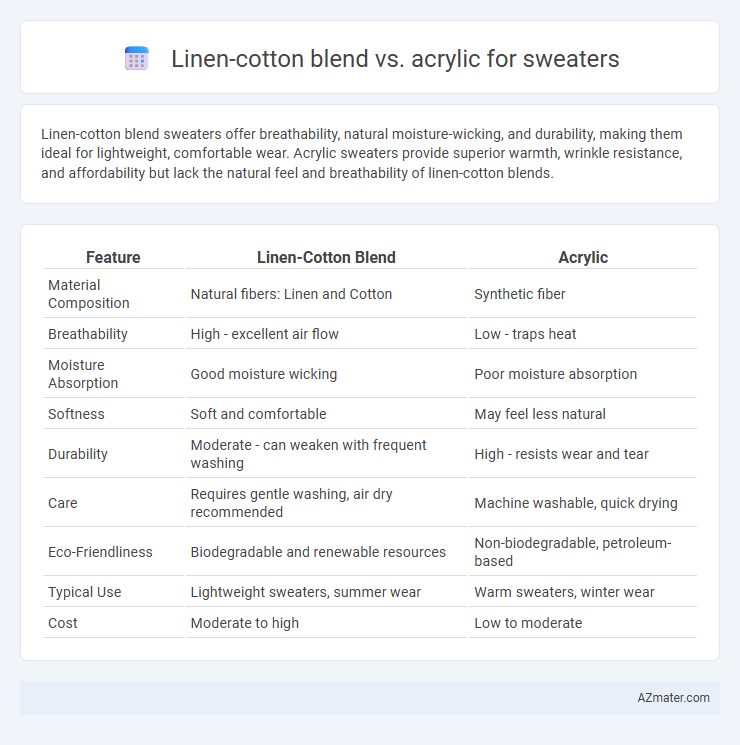Linen-cotton blend sweaters offer breathability, natural moisture-wicking, and durability, making them ideal for lightweight, comfortable wear. Acrylic sweaters provide superior warmth, wrinkle resistance, and affordability but lack the natural feel and breathability of linen-cotton blends.
Table of Comparison
| Feature | Linen-Cotton Blend | Acrylic |
|---|---|---|
| Material Composition | Natural fibers: Linen and Cotton | Synthetic fiber |
| Breathability | High - excellent air flow | Low - traps heat |
| Moisture Absorption | Good moisture wicking | Poor moisture absorption |
| Softness | Soft and comfortable | May feel less natural |
| Durability | Moderate - can weaken with frequent washing | High - resists wear and tear |
| Care | Requires gentle washing, air dry recommended | Machine washable, quick drying |
| Eco-Friendliness | Biodegradable and renewable resources | Non-biodegradable, petroleum-based |
| Typical Use | Lightweight sweaters, summer wear | Warm sweaters, winter wear |
| Cost | Moderate to high | Low to moderate |
Introduction: Comparing Linen-Cotton Blend and Acrylic for Sweaters
Linen-cotton blend sweaters offer natural breathability, moisture-wicking properties, and a soft texture ideal for warmer climates, while acrylic sweaters provide strong insulation, durability, and resistance to moths and wrinkles. The linen-cotton blend combines renewable plant fibers for eco-friendly comfort, contrasting with acrylic's synthetic polymer base derived from petrochemicals. Choosing between these materials depends on desired warmth, sustainability, and fabric maintenance preferences.
Material Composition: What Are Linen-Cotton and Acrylic?
Linen-cotton blend sweaters combine natural fibers from flax plants (linen) and cotton plants, offering breathability, moisture absorption, and softness. Acrylic sweaters are made from synthetic polymers designed to mimic wool, providing warmth and durability with added resistance to wrinkles and shrinkage. Choosing between them depends on preferences for natural fiber comfort and breathability versus synthetic fiber resilience and easy care.
Comfort and Feel: Softness, Breathability, and Texture
Linen-cotton blend sweaters offer exceptional breathability and moisture-wicking properties, ensuring a soft, natural feel that enhances comfort during warmer weather. The texture of linen combined with cotton creates a lightweight, smooth fabric that remains cool and gentle on the skin. Acrylic sweaters, while soft and warm, typically lack the same breathability and can feel less natural, often resulting in a slightly synthetic texture and reduced comfort in fluctuating temperatures.
Warmth and Insulation: Which Keeps You Warmer?
Linen-cotton blend sweaters offer moderate warmth with breathable properties, making them ideal for mild temperatures but less effective in retaining heat during cold weather. Acrylic sweaters provide superior insulation and retain warmth efficiently due to their synthetic fibers mimicking wool's heat retention capabilities. For optimal warmth and insulation, acrylic outperforms linen-cotton blends, especially in colder climates.
Moisture-Wicking and Breathability Properties
Linen-cotton blend sweaters excel in moisture-wicking and breathability due to natural fibers that allow air circulation and quick evaporation of sweat, making them ideal for warm weather wear. Acrylic sweaters, while often softer and more durable, lack the same breathability and moisture management, which can lead to increased heat retention and discomfort in humid conditions. Choosing a linen-cotton blend optimizes comfort by keeping the skin dry and cool through superior moisture absorption and ventilation.
Durability and Longevity: Which Lasts Longer?
Linen-cotton blend sweaters offer excellent durability due to the natural strength of both fibers, maintaining their shape and texture over time with proper care. Acrylic sweaters are known for their resistance to wear and tear, but they may pill and lose elasticity faster than linen-cotton blends. Generally, linen-cotton blends last longer than acrylic by retaining breathability and structural integrity through repeated use and washing.
Care and Maintenance: Washing and Storing Tips
Linen-cotton blend sweaters require gentle washing with cold water and mild detergent to prevent fabric shrinkage and maintain fiber integrity, while acrylic sweaters tolerate machine washing but benefit from low-temperature settings to avoid heat damage. Air drying is recommended for linen-cotton blends to preserve texture, whereas acrylic sweaters can be tumble dried on low heat without losing shape. For storage, linen-cotton garments should be folded and kept in breathable containers to prevent moisture buildup, while acrylic sweaters are best stored in cool, dry places away from direct sunlight to reduce pilling and discoloration.
Environmental Impact: Sustainability Considerations
Linen-cotton blend sweaters have a lower environmental impact due to their natural, biodegradable fibers and sustainable farming practices, including reduced water usage and minimal chemical inputs. Acrylic sweaters, derived from petroleum-based synthetic fibers, contribute significantly to fossil fuel depletion, microplastic pollution, and are non-biodegradable, causing long-term environmental harm. Choosing linen-cotton blends supports eco-friendly textile production and reduces the carbon footprint compared to acrylic alternatives.
Cost Comparison: Budget-Friendly Choices
Linen-cotton blend sweaters generally have a higher initial cost due to the natural fibers and breathability they offer, but their durability ensures long-term value. Acrylic sweaters tend to be more budget-friendly upfront, making them accessible for cost-conscious shoppers, though they may wear out faster over time. Choosing between these materials depends on balancing immediate affordability with potential longevity and comfort.
Best Uses and Style Recommendations
Linen-cotton blends offer breathable, lightweight comfort, ideal for warm weather sweaters and casual, relaxed styles that emphasize natural texture and durability. Acrylic sweaters are better suited for cooler climates thanks to their excellent insulation, vibrant color retention, and easy-care properties, making them perfect for versatile everyday wear and sporty designs. Choosing between the two depends on the desired balance of breathability and warmth, with linen-cotton blends excelling in summer layering and acrylic providing cozy winter options.

Infographic: Linen-cotton blend vs Acrylic for Sweater
 azmater.com
azmater.com